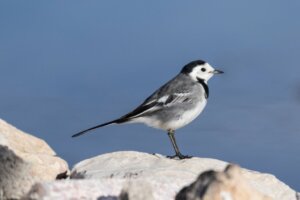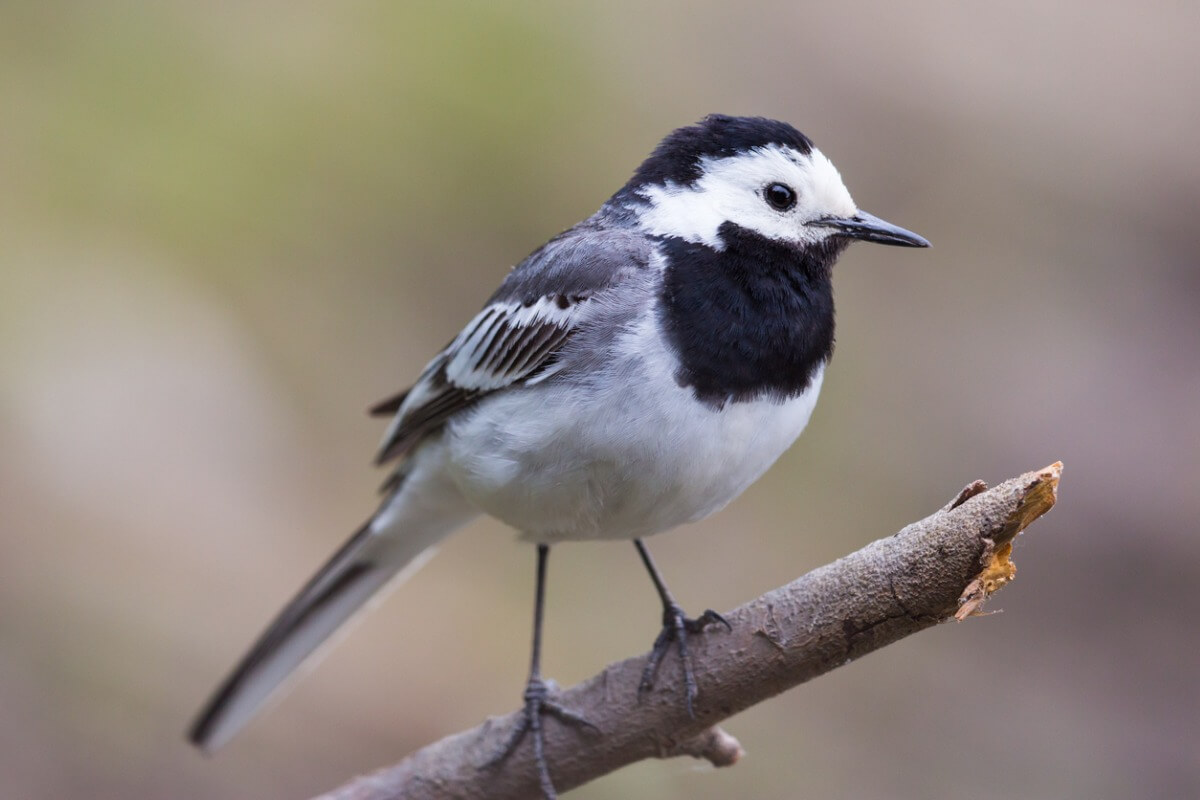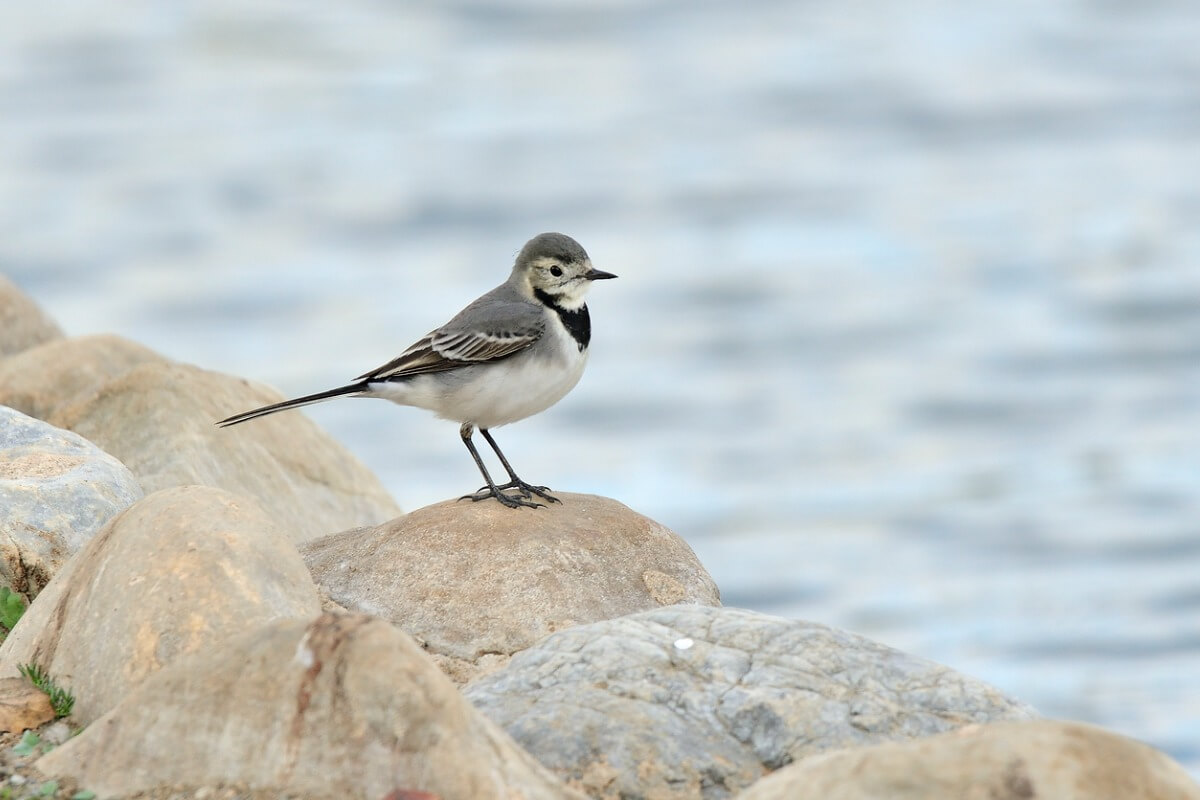White Wagtail: Habitat and Characteristics


Reviewed and approved by the biologist Samuel Sanchez
The white wagtail (Motacilla alba), also popularly known as the snow wagtail, is a small bird belonging to the family Motacillidae. Its presence in some regions is associated with the arrival of winter.
This bird can easily adapt to almost any habitat and doesn’t fear the presence of man, which is why it’s common to see it in crowded cities. Below, you’ll find plenty of information about this curious bird.
Habitat of the white wagtail
This bird is distributed throughout Europe, Asia, and North Africa. It can also inhabit temperate and cold areas of Eurasia, Alaska, and Greenland. During the winter it moves through Africa and southern Asia, north of the equator.
However, the 11 subspecies – sometimes considered isolated species – of the white wagtail frequent a specific place that clearly differentiates them. Thus, their geographic instability is evident, as the species is found in distinct territories.
In general, this bird prefers open, sunny areas with low vegetation and abundant water. Likewise, it can be seen near houses on farms, in villages, or in large cities. The white wagtail avoids dry areas and dense forests.

Physical characteristics
The white wagtail is a small bird measuring 16 to 19 centimeters in length (6 to 8 inches), with a wing diameter of about 28 centimeters (11 inches). Interestingly, this bird has a long tail that is always in motion and a very elegant plumage that makes it easy to identify.
This plumage has white, black, and grayish tones. Its back is ash gray, its belly is white and its wings are usually black with some white stripes that can be seen when they’re folded in. Its legs and beak are black, as is the center of its white face and the top and bottom of its head.
This animal has a succinct sexual dimorphism, as the male has a white belly while its chest and back are black. Its tail is long and black with a white rim. The female is quite similar to the male physically, but her dorsal colors are a bit lighter.
Juveniles of this species have a light grayish head and black legs and bill. Likewise, the young show more chromatic uniformity than the adults, don’t have black on the head, and have a grayish stripe in the pectoral region.
During the winter season, the white wagtail exhibits a similar plumage, although the black color on its head is more reduced and it has a white throat with a black stripe on the breast. Both sexes are very similar, but the female differs thanks to the gray feathers on its nape.
White wagtail behavior
Although the white wagtail is considered a sedentary species, it tends to move unsteadily over short and medium distances. Specimens can move in winter from central and eastern Europe to the Mediterranean basin and Africa. In Spain, they’re frequently sighted between October and November and during the spring (between February and April).
On the other hand, one of the most striking curiosities of this species is that it seeks refuge from predators in the avenues of large cities, where adults tend to nest. Also, large groups tend to gather during the night in urban areas to sleep, and, at dawn, they move to the meadows outside the city.
Another striking aspect of the white wagtail is that it can scamper nimbly over the ground in search of food. It has also been seen pecking the ground and perching near surface water (such as stream edges) to catch aquatic organisms.
The white wagtail often makes its nests inside abandoned objects, using pieces of wood and dry twigs. Likewise, it can nest between large nest spaces of other birds, as do other species (sparrows, for example).
Food of the white wagtail
As for its diet, this small bird includes in its diet a wide variety of insects both terrestrial and aquatic, as well as other small invertebrates such as spiders, crustaceans, mollusks, and fish. The white wagtail may also feed on plants and grasses in the open fields it frequents.
Reproduction of the white wagtail
This bird usually protects the territories where it nests, building nests under tiles or stones, on walls and walls, or hidden among vegetation (which may consist of ivy). The female usually lays 5 to 6 brownish-mottled gray eggs, which incubate for 11 to 16 days.
The parents will feed the chicks until they leave the nest at 16 days of age, although they may be cared for a little longer.
Conservation status
According to the Red List of the International Union for Conservation of Nature (IUCN), the conservation status of the white wagtail is of “Least Concern (LC)”. So far, no direct threats to this species have been detected, although it could be affected in the future by many general changes.
Loss of natural habitat due to increasing urbanization and indiscriminate use of pesticides may affect this species in the future.

As you could appreciate, the white wagtail is a bird that covers a wide territory, and throughout history has been associated with the arrival of winter in many regions. Although its breeding isn’t very distinctive, its behavior does present different striking aspects that make this species unique.
The white wagtail (Motacilla alba), also popularly known as the snow wagtail, is a small bird belonging to the family Motacillidae. Its presence in some regions is associated with the arrival of winter.
This bird can easily adapt to almost any habitat and doesn’t fear the presence of man, which is why it’s common to see it in crowded cities. Below, you’ll find plenty of information about this curious bird.
Habitat of the white wagtail
This bird is distributed throughout Europe, Asia, and North Africa. It can also inhabit temperate and cold areas of Eurasia, Alaska, and Greenland. During the winter it moves through Africa and southern Asia, north of the equator.
However, the 11 subspecies – sometimes considered isolated species – of the white wagtail frequent a specific place that clearly differentiates them. Thus, their geographic instability is evident, as the species is found in distinct territories.
In general, this bird prefers open, sunny areas with low vegetation and abundant water. Likewise, it can be seen near houses on farms, in villages, or in large cities. The white wagtail avoids dry areas and dense forests.

Physical characteristics
The white wagtail is a small bird measuring 16 to 19 centimeters in length (6 to 8 inches), with a wing diameter of about 28 centimeters (11 inches). Interestingly, this bird has a long tail that is always in motion and a very elegant plumage that makes it easy to identify.
This plumage has white, black, and grayish tones. Its back is ash gray, its belly is white and its wings are usually black with some white stripes that can be seen when they’re folded in. Its legs and beak are black, as is the center of its white face and the top and bottom of its head.
This animal has a succinct sexual dimorphism, as the male has a white belly while its chest and back are black. Its tail is long and black with a white rim. The female is quite similar to the male physically, but her dorsal colors are a bit lighter.
Juveniles of this species have a light grayish head and black legs and bill. Likewise, the young show more chromatic uniformity than the adults, don’t have black on the head, and have a grayish stripe in the pectoral region.
During the winter season, the white wagtail exhibits a similar plumage, although the black color on its head is more reduced and it has a white throat with a black stripe on the breast. Both sexes are very similar, but the female differs thanks to the gray feathers on its nape.
White wagtail behavior
Although the white wagtail is considered a sedentary species, it tends to move unsteadily over short and medium distances. Specimens can move in winter from central and eastern Europe to the Mediterranean basin and Africa. In Spain, they’re frequently sighted between October and November and during the spring (between February and April).
On the other hand, one of the most striking curiosities of this species is that it seeks refuge from predators in the avenues of large cities, where adults tend to nest. Also, large groups tend to gather during the night in urban areas to sleep, and, at dawn, they move to the meadows outside the city.
Another striking aspect of the white wagtail is that it can scamper nimbly over the ground in search of food. It has also been seen pecking the ground and perching near surface water (such as stream edges) to catch aquatic organisms.
The white wagtail often makes its nests inside abandoned objects, using pieces of wood and dry twigs. Likewise, it can nest between large nest spaces of other birds, as do other species (sparrows, for example).
Food of the white wagtail
As for its diet, this small bird includes in its diet a wide variety of insects both terrestrial and aquatic, as well as other small invertebrates such as spiders, crustaceans, mollusks, and fish. The white wagtail may also feed on plants and grasses in the open fields it frequents.
Reproduction of the white wagtail
This bird usually protects the territories where it nests, building nests under tiles or stones, on walls and walls, or hidden among vegetation (which may consist of ivy). The female usually lays 5 to 6 brownish-mottled gray eggs, which incubate for 11 to 16 days.
The parents will feed the chicks until they leave the nest at 16 days of age, although they may be cared for a little longer.
Conservation status
According to the Red List of the International Union for Conservation of Nature (IUCN), the conservation status of the white wagtail is of “Least Concern (LC)”. So far, no direct threats to this species have been detected, although it could be affected in the future by many general changes.
Loss of natural habitat due to increasing urbanization and indiscriminate use of pesticides may affect this species in the future.

As you could appreciate, the white wagtail is a bird that covers a wide territory, and throughout history has been associated with the arrival of winter in many regions. Although its breeding isn’t very distinctive, its behavior does present different striking aspects that make this species unique.
All cited sources were thoroughly reviewed by our team to ensure their quality, reliability, currency, and validity. The bibliography of this article was considered reliable and of academic or scientific accuracy.
- SEOBridLife. Lavandera blanca. Recogido el 18 de octubre de 2021 de: https://seo.org/ave/lavandera-blanca/
- BirdLife International. 2019. Motacilla alba. The IUCN Red List of Threatened Species 2019: e.T22718348A137417893. Recogido el 19 de octubre de 2021 de: https://dx.doi.org/10.2305/IUCN.UK.2019-3.RLTS.T22718348A137417893
This text is provided for informational purposes only and does not replace consultation with a professional. If in doubt, consult your specialist.








